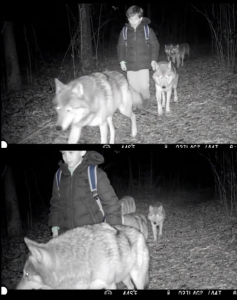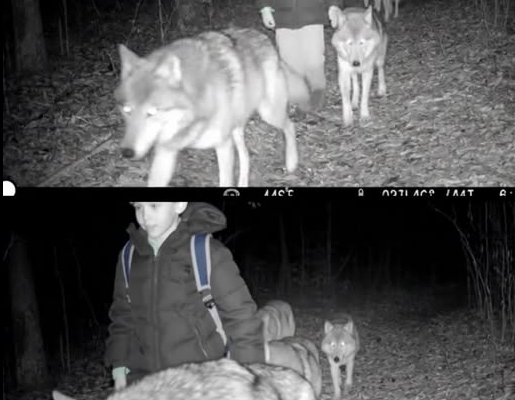
The Incredible True Story of a Lost Boy and His Wolf Protectors
In the heart of the Siberian wilderness, where the wind howls through endless forests and snow blankets the land for most of the year, an unbelievable story emerged—one that blurred the lines between man and beast, survival and legend. It is the story of a young boy who, after becoming lost in one of the harshest environments on Earth, found protection and companionship not from humans, but from wolves. Though it sounds like a fable, this tale has roots in real accounts of human resilience and the strange, ancient bond between mankind and nature’s fiercest predator.
A Boy Lost in the Wilderness
It began on what was supposed to be an ordinary day. In a small village on the edge of the Siberian taiga, a seven-year-old boy wandered off while his father chopped wood near their home. The air was crisp, and the forest’s quiet beauty drew him farther from safety. Within hours, snow began to fall heavily, covering his tracks. Panic set in as daylight faded and the temperature plummeted below freezing. Despite an extensive search by his family and neighbors, there was no sign of the boy. As night fell, most feared the worst—that he had succumbed to the cold or been taken by wild animals.
The Wolves Appear
Days passed, and hope began to fade. But deep in the forest, something extraordinary was happening. A small pack of wolves—led by an aging alpha female—had found the shivering, hungry child. Rather than attacking, the wolves circled him cautiously, sniffing the air. Perhaps they sensed weakness or recognized something in his cries that reminded them of their own young. Instead of becoming prey, the boy was accepted.
Witness accounts gathered later from local hunters suggest that the wolves allowed the boy to stay near their den. He was seen months later, barefoot, his hair matted, but alive—and astonishingly, he was surrounded by wolves that seemed to guard him as one of their own.
Life Among Wolves
For nearly two years, the boy lived in the wilderness. What he ate, how he survived the bitter winters, and how he learned to communicate with the animals remain mysteries. Experts who studied feral children suggest he may have mimicked the wolves’ behavior to gain their trust—crawling, growling, even eating raw meat. His body adapted to the cold, his senses sharpened, and he learned to move quietly through the snow.
The pack, it seemed, provided both warmth and food. Wolves are social creatures; they care for their own. The boy likely benefited from this natural order. The older wolves hunted, while younger ones guarded the den. When the pack rested, the boy would curl up beside them, wrapped in their thick fur, shielded from the Siberian frost.
Discovery and Rescue
Hunters eventually stumbled upon the boy while tracking wolves near a frozen river. At first, they couldn’t believe what they were seeing—a human child running with wolves, moving on all fours, and making guttural sounds instead of words. When they tried to approach, the wolves formed a protective circle, snarling and baring their teeth. Only after the pack’s leader gave a low whine did the others back away, allowing the hunters to take the boy.
It took days to bring him back to civilization. Malnourished and terrified of people, he resisted human contact. Doctors were stunned by his physical condition: he was strong, agile, and his reflexes were more animal-like than human. It took months before he began to speak again and years before he could fully reintegrate into society.
The Science Behind the Bond
Animal behaviorists have long studied the relationship between humans and wolves, noting that both species share social structures centered around family and cooperation. The bond between early humans and wolves, forged thousands of years ago, eventually led to the domestication of dogs. The story of the “wolf boy” is a haunting echo of that ancient connection—a reminder that beneath our modern lives, the instinct for survival and kinship with nature still lives within us.
In this case, scientists believe the wolves’ acceptance of the boy might have been influenced by a combination of environmental and social factors. Wolves sometimes adopt orphaned pups or injured animals from outside their pack. The boy’s small size, non-threatening behavior, and vulnerability could have triggered the wolves’ protective instincts.
Struggle to Adapt
After being rescued, the boy faced new challenges. He had to relearn how to speak, walk upright, and live within human society. Psychologists who worked with him described deep emotional trauma, but also an unusual calm when he heard wolf howls or saw images of the forest. For years, he struggled with identity—half-human, half-wild. The wolves had kept him alive, but they had also imprinted a way of life that could not easily be erased.
Even as he grew older, he often returned to the edge of the forest, sitting silently as if waiting for something—or someone. Villagers claimed they saw wolves appear in the distance during these visits, watching but never approaching. Some believed they recognized him, a member who had left the pack but was never forgotten.
Legacy of the “Wolf Child”
The story of the lost boy and his wolf protectors has fascinated scientists, philosophers, and storytellers alike. To some, it’s a testament to nature’s compassion and adaptability; to others, it’s a cautionary tale about isolation and the fragile line separating civilization from the wild.
While many details remain uncertain—lost to time and conflicting reports—the core truth endures: a young boy survived one of Earth’s harshest environments, not through technology or luck, but through the unlikely mercy of animals that most humans fear.
Today, his story is studied alongside other cases of feral children, each revealing different facets of human nature and survival. But few tales are as moving or mysterious as this one. The boy’s life reminds us that connection can transcend species, that survival often depends on empathy, and that even in the untamed wild, compassion exists in unexpected forms.
Conclusion
The tale of the lost boy and his wolf protectors stands as a powerful symbol of coexistence and instinct. It shows how, in moments of desperation, the natural world can become both adversary and savior. Whether viewed as a scientific phenomenon or a living legend, it stirs something primal within us—the part that yearns for freedom, loyalty, and the unbreakable bond between life and nature.
Long after the boy rejoined society, the wolves continued to roam the Siberian forests, their howls echoing across the snow-covered land—a haunting lullaby for the child they once called their own.

